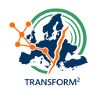Maximizing Societal Impact
The success of the program does not solely rely on its research, scientific, and technological achievements in the field of earthquake research and monitoring. Equally important is the maximization of the broader societal impact of these outcomes.
Enhanced safety for citizens: The TRANSFORM² outputs (e.g. EEWS tailored to the next generation of European NFO) have a very high potential impact for society and could benefit citizens by changing the way earthquake monitoring is performed. Taking a broader view, such systems may prove very useful for monitoring many earthquake-prone countries in Europe, as well as for ultra-peripheral Europe.
Raised social awareness and community resilience.: TRANSFORM² results will be openly accessible, and the public will have direct access as well. TRANSFORM2’s tools, including next-generation Earthquake Early Warning Systems (EEWS), have the potential to significantly improve earthquake monitoring across Europe. The project also emphasizes public engagement, ensuring open access to results and data and delivering early warning alerts to end-users, ultimately raising social awareness and community resilience.
In the long term, TRANSFORM²’s achievements will lay solid foundations to ensure the sustainability of infrastructures and the development of new services (e.g., Earthquake Early Warning systems), both at the NFO level and for wider use by stakeholders and society at large.
Scientific Contribution and New Research Directions
The project is expected to deliver a direct scientific contribution and open new research directions in earthquake monitoring. By introducing innovative instrumentation, advanced processing methods, automated workflows, and cutting-edge technologies (such as fiber-optic sensors, Machine Learning, and Artificial Intelligence), TRANSFORM² will significantly enhance earthquake monitoring capabilities and foster new research opportunities at the forefront of science.
Attracting Private Sector Stakeholders
TRANSFORM² is designed as a bottom-up approach. NFOs being natural laboratories/observatories can act as valuable test-beds. Until now, NFOs have already engaged researchers and scientists, and industrial stakeholders. This interaction has revealed the potential of the various stakeholders to act both as a feedback mechanism and as potential partners. NFOs can thus offer accumulated knowledge, accessibility, and hosting facilities, acting as testbeds capable of attracting private sector stakeholders to participate in new developments.
Such synergies are key to ensuring the long-term sustainability of the proposed infrastructure. If TRANSFORM² succeeds in generating this paradigm shift, it will represent a major contribution to future innovation, development, and sustainability.
Strengthening the Link between Academia and Policy
The project aims to reinforce the connection between academia and policymaking in earthquake management, fostering of collaboration with Civil Protection authorities and the enhancement of public safety.
NFOs have already engaged researchers, scientists, and industrial stakeholders, creating fertile ground for knowledge exchange and the development of synergies. This interaction highlights the potential of stakeholders to act both as feedback mechanisms and as active partners in the innovation ecosystem. >

